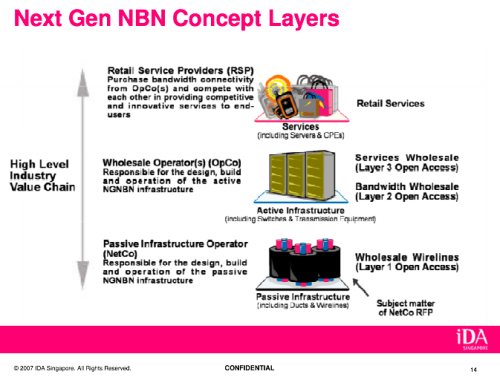Several weeks ago, Dr Lee Boon Yang, Minister for Information, Communications And The Arts, announced the launch of the RFP National Broadband Network (NBN) project for Singapore. The NBN project comes with a carrot of S$750m is a passive optical network fiber to the home (FTTH) that “will offer pervasive and competitively priced ultra high-speed broadband connectivity to business users at the workplace as well as to Singaporeans at home, schools and learning institutions and other premises.”
Surprisingly, there aren’t so much talks in the industry about the project. Perhaps it is something almost everyone wants to part-take as we can see from the 12 shortlisted consortium. The most prominent comment is a single word “Idiosyncratic” said the CEO of Telstra, who have no direct interest in this effect except perhaps not to see Australia going down the same path.
The comment probably refers to the layer separation of the services1 (see NBM slides Page 14)

Such structure separation is definitely unusual in an industry that is used to vertical integration with a monopoly over infrastructure and services. Amsterdam FTTH that has a similar model2.
While the goal of NBN is to provide high speed wired data services to residents, there is a balance to ensure there is open access and competitions in the marketplace. Creating competition is challenging because infrastructure is a “nature monopoly”.
To have a perfect competition, we need to have two or more companies having duplicate set of infrastructure. However, it often does not make sense to have duplicate fiber to your competitors unless there is strong demand to justify it. So most of the time, operators end up owning infrastructure that don’t overlap with each another.
Another way to look at this is that for a dark fiber network, the cost of the fiber is actually only a small fraction of the capital expenses. Most of it goes into the acquiring the right of way and construction of the duct. So what if the operators get together to share the cost of everything else but own their own fiber, ie the concept of an “open duct”. That might have competition on fiber but we create an monopoly ownership on telecommunication duct.
It is really a hard problem and no matter how you slice it, there is some part which is have no or little competition3. By now, Bill Woodcock probably screaming “Just give any and everyone who wants to build fiber the license and right of way!”. Sadly, there are enough oppositions to this “anything goes” idea that it won’t fly over here at this moment.
So IDA decided “Okay, I know some part would always be monopoly. So I am going to make that part as small as possible and going to put a lot of rules to regulate it”. And thus we end up having a multi-tier structure: a common duct and dark fiber operator (NetCo) who would lease dark fiber to multiple operators would would light up these fiber with equipments (OpCo) who would in-turn wholesale bandwidth to retail service operator (RSP). Expect to see only one NetCo. Or if there is more than one NetCo, the network is unlikely to overlap. And expect NetCo to be heavily regulated.
For Telstra, that is an alien concept since Telstra is NetCo, OpCo and RSP all rolled into one. It is “idiosyncratic”.
But for one who wants to see open access and competitions in the market, this is a big step in a right direction.
1 IDA has done their homework. A public consultation was called last year and only 5 out of 33 did not support structural separation of operation and retail proposed.
2 I blogged in 2004 about transformation into an horizontal layering model. In some way, it is gratifying to see that I am right (woohoo! :-). However, I claim no credit in NBN nor have any involved in it even though I was working in IDA when the project was started.
3 Many years ago, when I first joined IDA, I thought I could try to bring the prices of infrastructure down so I started embark on an impossible mission. First, I discovered that few people really want to build more fiber – if anything else Singapore has too much dark fiber.
Then I discover one company owns all the ducts and dark fibers, a legacy of a privatization many years ago. Getting that company to lease dark fiber is, hmm, how should I put it…Let me quote my dear friend Mohamed Sharil Tarmizi (now a commissioner of MCMC) “the workings of the mind of a monopoly is beyond comprehension” as he related to me over a tek terik one late night how the operator in Malaysia rather let their fiber rot in the duct then to lease it below “market price” which is (wow) determined by them.
We even toyed with the idea of acquiring all the duct and dark fiber back so it can be release back in the market but alas, we are just dreaming.
This post is delicated to Brough Turner who email me about NBN shortly after the announcement. :-)